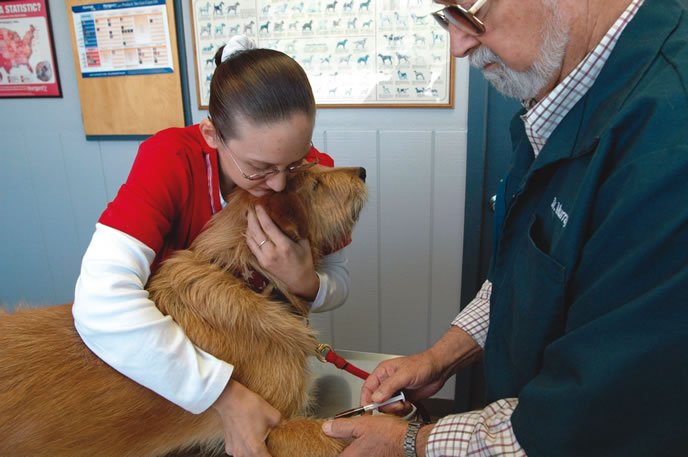
Made up of water, proteins, nutrients, and living cells, your dog’s blood is a biochemical tapestry, a complex canvas of interwoven values that, taken as a whole, offer a vividly detailed image of her state of health. Virtually every major organ of the body contributes its own threads, as do external things that you control, such as diet.
“Blood work” – that overarching term used by medical professions to refer to a buffet-like spread of blood-based tests and diagnostics – is the way veterinarians deconstruct what the body is doing, through the evidence its various organs and systems leave in the bloodstream. Whether a dog is healthy, ailing, or perhaps just a bit “off,” blood work often plans a key role in determining her state of health. (Of course, blood work is just one diagnostic tool, and a physical exam as well as medical history are also important components in arriving at a diagnosis or wellness plan.)
What is open for debate, depending on your individual dog, is when to do bloodwork, how extensive it should be, and who should do it.
Two Disease Testing Groups
When a veterinarian recommends doing “blood work” on your dog, chances are likely that she is referring to two distinct groups of tests.
The first is a CBC, short for complete blood count. This catchy acronym covers a trio of cellular elements found in the blood: red and white blood cells and platelets. All three have different functions, and provide different information to your veterinarian. Generally speaking, a CBC is useful for uncovering underlying conditions such as infection or anemia, which is a lack of healthy red blood cells.
Red blood cells transport oxygen to the body’s cells, exchanging it for carbon dioxide to be carried back to the lungs, where the process begins anew. The CBC examines the levels of hemoglobin, which gives blood its distinctive red color and is responsible for transporting oxygen. Decreased hemoglobin levels might mean a dog has a reduced oxygen capacity – a critical finding if he is to undergo anesthesia. Another important value is hematocrit (also called PCV, or packed cell volume), which measures the amount of space that red blood cells take up in the blood.
When these values are too low, the dog may be anemic, which isn’t a disease itself but rather an indicator of an underlying problem, such as poor nutrition, parasites such as hookworms, chronic infection, and even cancer, inflammatory bowel disease or hormonal issues with the thyroid and adrenal glands. Conversely, a high red blood cell count could signal kidney disease, cancer, or an acute condition such as dehydration.
White blood cells are made in the bone marrow, and are involved in battling infection and inflammation. There are five different types of white blood cells, and abnormal counts in each can mean different things. Levels of eosinophils, for example, are often high if a dog has a parasitic or allergic condition, while a dog with elevated neutrophils – which typically are the first to attack inflammation, and so are among the most common white blood cells – might be dealing with an infection.
The third type of cell found in the blood, platelets, help the blood to clot. When levels are low, the chances of bruising and bleeding are elevated – again, important to know if your dog is about to go under the knife. Low platelet counts can be caused by infectious and immune-mediated diseases, such as tick-borne diseases like ehrlichiosis, as well as use of certain drugs.
The second group of tests your veterinarian might order is often called a blood chemistry, or metabolic panel. This battery of tests – more than two dozen of them, if your vet checks off all the boxes – assesses the function of important organs like the heart, liver, adrenal glands, and kidneys by measuring fats, proteins, sugar, electrolytes (potassium, magnesium, sodium, and calcium), and enzymes, which provide information about organ function.
A common blood-chemistry value that owners often hear about is BUN, or blood urea nitrogen test, which measures how well the kidneys filter waste. Along with creatinine (another waste product produced by the kidneys), BUN gives a picture of renal health. High BUN levels may indicate incomplete absorption of proteins from the bowel at time of collection, a raw diet, or kidney disease, which is serious, if the creatinine is also elevated, or they could be a sign of something as potentially reversible as dehydration.
Better Safe Than Sorry
Blood work isn’t just a good idea for dogs who are unwell and in need of diagnosis. They are also important for healthy dogs – particularly before a surgical procedure. Most veterinarians insist on pre-surgical blood tests out of concern for possible complications from anesthesia.
“Blood work before surgery is absolutely needed,” regardless of a dog’s age or health status, says W. Jean Dodds, DVM, founder of Hemopet, a blood bank program for animals. “The number of cases where this was not done and a significant subclinical problem was missed is relatively large. About 50% of dogs in published studies have lab-test abnormalities on routine screening.”
Dogs who have abnormal results can have their surgery rescheduled if it is an elective one so the problem can be addressed. Or the veterinarian might opt to go ahead, but handle some aspects of the procedure differently – perhaps using sedation with a local anesthetic instead of general anesthesia, or administering intravenous fluids before surgery.
Owners may of course opt to forego pre-surgical blood work for their dogs; at the end of the day, you are your dog’s advocate, and have the final say about his care. Just remember that increasingly, some vets have made pre-surgical testing mandatory because of the risk of a subclinical condition that can’t be otherwise detected. And if there is the possibility of a hidden complication that could compromise your dog’s health, isn’t it worth the investment to find out?
First Time Blood Work
If your dog has a healthy and medically uneventful puppyhood, the first time blood work will be done is likely before spaying or neutering, typically as a juvenile or young adult.
When it comes to pre-surgical blood work in this scenario, “the main goal is to look for subclinical, or hidden, congenital liver or kidney problems,” says Julie Meadows, DVM, a clinical professor of primary care at the University of California’s School of Veterinary Medicine at Davis. Ensuring that the liver and kidneys are not compromised is crucial, because those organs do the heavy lifting in clearing anesthesia-related toxins from the body.
A partial panel for a healthy young dog like this might include BUN and creatinine, to gauge kidney function; ALT (Alanine aminotransferase, an enzyme that becomes elevated with liver disease), and total protein, which can signal hydration as well as liver and kidney function. In addition, Dr. Meadows says, many vets might also include PCV, or packed cell volume, “to assess the red blood cell count and screen for anemia.”
While many owners might never think of running blood work on dogs this young, Dr. Meadows underscores the importance of having some key values – “the biggies” – on board before putting the dog under. But there is such a thing as overkill. For a well-dog visit, “I would not expect a general practitioner to do a complete chemical panel and complete urinalysis,” she adds. “Those are things we do when an animal is sick.”
Baseline Blood Values
Most vets agree about the importance of pre-surgical blood work, and of establishing baseline blood values while a dog is healthy, so that later changes, if they happen, can be analyzed in context. But when it comes to determining when to get that baseline, and how often to check blood work throughout a dog’s lifetime, veterinary opinions vary.
In Dr. Dodds’ opinion, “for healthy dogs, an annual wellness physical exam and full laboratory testing are important. If the dog has any chronic low-grade or other condition, even in remission, testing every six months is wise.” And dogs who have been put on new, long-term medication, especially drugs that can tax the liver and kidneys, such as nonsteroidal anti-inflammatories like Rimadyl and Deramaxx, will need periodic blood work to ensure their bodies are processing them properly.
Because there are so many blood values to choose from, some veterinarians may order a partial blood panel, which Dr. Dodds says is typically “just a few of the serum chemistries, without electrolytes, and without amylase and lipase to assess pancreatic function.” She personally does not recommend partial panels, as she believes leaving out potentially important values in the chemical analysis can be “misleading.”
Dr. Dodds feels the following are critical for understanding a dog’s state of health: a CBC, complete serum chemistries, thyroid profile (a minimum T4 and freeT4 values, with TgAA added for breeds known to be at risk for autoimmune thyroiditis), and urinalysis. She adds that in an initial workup, the pancreatic enzymes (amylase and lipase) should always be run.
In an otherwise healthy dog, Dr. Meadows believes middle age – around five, six, or seven years old – is an ideal time to do a baseline CBC and chemistry panel, as well as a urinalysis.
“We aren’t expecting things to be wrong” at this age, she says. “If we do that lab work, we’re saying, ‘This is where the lab work ought to be at this age.'”
Similarly, there is by no means consensus about the age at which to consider a dog “geriatric.” Dr. Meadows uses 10 as a ballpark, but acknowledges that others’ mileage may vary. (And in some giant breeds, which tend to be shorter lived, senior-citizen status starts much earlier.)
In contrast to the mid-life baseline, blood work for a senior dog is “where we’re expecting lab values to start to change,” Dr. Meadows says. As for frequency, “it’s sometimes helpful to have a rate of change,” so that your veterinarian can track progress more accurately.
Once a dog hits his golden years, many veterinarians recommend annual blood work, in order to pick up problems early and try to address them before they begin to snowball. “With true senior screening lab work, we’re looking for things, and expecting to find them, because we want to intervene and slow things, and prevent a crisis,” Dr. Meadows explains.
This allows veterinarians to practice preventive medicine, she continues. “The glory of preventive health care is it gives a better outcome over time. If a dog’s liver numbers are perpetually trending up, I’d want to touch base with the family about what our options are, and how proactive they want to be with microinterventions to try to slow the progress of disease.”
In-House Veterinary Lab Work
Most all veterinary practices have a national diagnostic laboratory, such as Idexx or Antech, to which they send their blood samples. But most veterinary practices also have the ability to do in-house lab work.
The decision on whether to go “in” or “out” is basically “a question of the economics,” Dr. Meadows says. For example, if a veterinarian really only wants to run BUN and creatinine levels, it might be far more economical to send the blood sample out than to run it in house.
Also, the capacities of in-house testing units will differ from practice to practice. And a veterinarian’s decisions will vary from patient to patient. “On a sick animal, you might want results on the same day,” she explains. “But if I need to know what your electrolytes are, and I don’t have that capacity in my practice, I might do part of the blood work in house, and part out. There are all these variables that go into it.”
For her part, Dr. Dodds feels that in-house tests “should be reserved for a quick look at the animal. They don’t look at amylase and lipase, for example, and provide only basic CBC differential assessment.” By contrast, she thinks “reference vet lab testing is more comprehensive and reliable,” with the added benefit of getting a professional review of the results from the laboratory.

Each Dog is Different
Dogs are individuals, and there may be valid reasons why their blood work might fall outside the range of normal, and still be perfectly fine.
For starters, “there are going to be breed differences,” says Dr. Meadows, offering sighthounds as an example. With their aerodynamic builds and low fat reserves, speedsters like Greyhounds and Salukis often have thyroid levels that are lower than other breeds. A primer that Dr. Meadows and many veterinarians refer to for breed-specific issues is Veterinary Medical Guide to Dog and Cat Breeds by Jerold S. Bell, DVM, and Kathleen Cavanagh, DVM, BSc.
Age is another variable in test results. For example, ” for thyroid testing, young dogs – puppies and adolescents – should have higher levels and older dogs – 10 or above – lower levels,” Dr. Dodds explains. The testing laboratories don’t provide reference ranges for thyroid levels of dogs based on breed type or age; they provide the same listed ranges for all dogs, which, Dr. Dodds says, “is obviously misleading and can be just wrong.”
Diet can also impact test results. “Raw-fed dogs can have several lab values that differ from those fed cereal kibbles – for example, BUN and red blood cell parameters,” she continues. “The BUN can be high with a normal creatinine if the animal is still digesting and clearing urea protein nitrogen from the bowel – this is often misread by vet clinics as indicating renal disease. In young dogs, the lymphocyte counts are higher and total protein lower.”
If your dog is raw-fed, be sure to inform or remind your vet before any blood work is done, especially before a surgical procedure. Don’t assume that she will know about this differential regarding raw-fed dogs; otherwise, you might find that you’re incurring costs for pre-surgical hydration, or cancellation of the surgery altogether, because your vet is unduly concerned.
Finally, says Dr. Dodds, drawing blood after an overnight fast (no food or water after midnight) is preferable. “If a dog takes medications, like thyroxine, testing should be four to six hours post-pill. For other medications like anticonvulsants, it may not matter but should still be stated on the test submission form.”
A dog’s diurnal rhythm peaks around 2 p.m., Dr. Dodds says, so try to schedule routine testing in the morning or mid-day. “At least have it be around the same time of day each time, to compare apples to apples and not oranges.”
Blood Work is Worth the Investment
If you’re bringing your dog into the vet for a “routine” procedure such as a dental cleaning or spay or neuter, that line item on the bill estimate for pre-surgical blood work may seem like an expendable one. Ditto for your vet’s request to do blood work during your dog’s annual wellness exam, even if she is the picture of health.
Of course, in the end, the decision is yours. And it is possible to take things too far, like running test after test to run down one errant, “off” chemistry value when the dog is otherwise healthy and happy. But be sure to keep in mind the fact that blood work can be very valuable as a bellwether for problems that might be invariably coming down the pike. And if the outcome is no problems at all, then you hang up the phone with that most valuable commodity of all: peace of mind.






This is excellent, thank you. My GSD of 7.5 years is due for surgery, but has an elevated BUN and creatinine level as well, but, his urine shows him concentrating well. If the urine test shows no issues, is it safe to say the dog’s kidneys are doing okay? Okay enough for minor dental surgery? I trust my vet, but I’m just wanting to know these details for myself so I understand them well. Thanks . . .